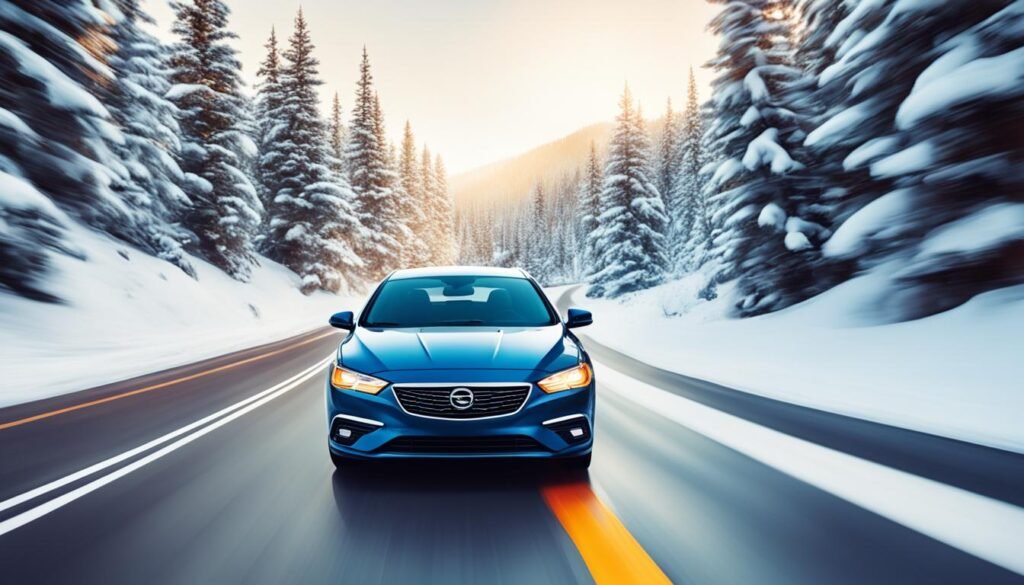Winter crashes cause a 17% jump in crashes, did you know? When it gets cold and snows, roads get dangerous, leading to more accidents. Yet, summer has its own dangers on the road. It’s important to know why crashes are more common in these seasons. This helps make roads safer and saves lives.
Key Takeaways:
- Winter crashes contribute to a 17% increase in overall crash rates.
- Understanding the factors that affect crash rates on summer roads is vital.
- Rain and snow have different effects on crash types, with snow impacting single-truck crashes and rain having a larger effect on single-car crashes.
- Sun glare increases the probability of multi-car crashes, particularly in rear-end collisions.
- High wind speeds increase the risk of single-truck crashes and crashes with objects blown onto the road.
The Impact of Weather on Crash Risk
Weather conditions greatly affect the chance of road crashes. Elements like rain, sun glare, and wind speed increase crash risks. Knowing these effects helps put safety steps in place.
Precipitation and Crash Risk
Precipitation, such as rain and snow, boosts crash chances by up to 84%. Snow mostly affects truck crashes, while rain impacts car crashes more. Slippery roads and poor visibility from these conditions urge drivers to be careful.
Sun Glare and Multi-Car Collisions
Sun glare can greatly increase the risk of crashes involving many cars. It happens when sunlight makes it hard to see the road and other cars. This often causes rear-end collisions at high speeds. Wearing sunglasses and adjusting mirrors can help.
“Sun glare occurs when sunlight interferes with a driver’s vision, making it harder to see the road ahead and anticipate potential hazards.”
High Wind Speeds and Road Hazards
High winds also create dangers on roads. They can lead to truck crashes and blow objects onto roads, causing accidents. Driving carefully in windy conditions is essential. This means slowing down and holding the steering wheel tightly.
Integrating Safety Measures
Understanding weather’s effect on crashes helps authorities make roads safer. They might limit driving in bad weather or use warning systems in cars. These steps help drivers avoid weather-related dangers.
By knowing how weather affects crashes and taking steps to improve safety, we make roads safer for everyone.
The Influence of Traffic Volume on Crash Rates
Traffic volume greatly impacts road safety and crash rates. Increased traffic volume leads to higher crash rates. This is because more vehicles on the road increase the chance of accidents.
It’s vital to understand how traffic volume affects crash rates. This knowledge helps in making roads safer. Authorities can set up strategies that encourage safe driving and minimize accidents.
Strategies include setting speed limits and improving road design. These help manage vehicle flow and enhance safety. Other measures can adjust based on risks like bad weather or big events.
These actions help in developing smart traffic management plans. By acknowledging traffic’s impact on safety, we can improve traffic management. This makes roads safer for everyone.
Benefits of Managing Traffic Volume
Good traffic management improves road safety and offers more benefits. These include:
- Reduced congestion: Proper traffic management helps alleviate congestion, resulting in smoother traffic flow and reduced travel times for drivers.
- Improved fuel efficiency: Reducing traffic congestion leads to decreased fuel consumption and lower emissions, contributing to a greener and more sustainable environment.
- Enhanced emergency response: Efficient traffic management ensures emergency vehicles can reach their destinations quickly and safely, improving emergency response times.
- Greater overall road efficiency: By optimizing traffic volume and flow, road networks can handle increased capacity, allowing for safer and more efficient transportation for all road users.
Considering traffic’s influence on crash rates is vital for safety planning. Proper measures can lower accident risks, enhance traffic management, and better the driving experience for all.
| Traffic Volume | Crash Rates |
|---|---|
| Low | Low |
| Moderate | Moderate |
| High | High |
Understanding the effect of traffic volume on crash rates is key to road safety.
Seasonal Driving Challenges
Each season brings different challenges for drivers on the road. Adverse weather, changing road conditions, and driver behavior all increase risks. Knowing these challenges is key to avoiding accidents.
Adverse Weather Conditions: Bad weather greatly affects driving. **Rain** can cause car crashes, while **snow** affects trucks more. **Sun glare** can lead to crashes at high speeds. High **wind speeds** can cause trucks to crash and blow debris onto roads.
Varying Road Conditions: The seasons also change road conditions. **Poor road conditions**, like potholes or ice, make driving risky. Drivers need to be careful and adjust how they drive.
The Role of Driver Behavior: How drivers act is crucial too. They might change how they drive based on the weather, which can be risky. It’s vital to keep a safe speed, drive defensively, and focus on the road.
| Seasonal Driving Challenges | Adverse Weather | Road Conditions | Driver Behavior |
|---|---|---|---|
| Precipitation | Rain, Snowfall | Poor road conditions | Adjusting driving habits |
| Sun glare | N/A | N/A | Staying focused |
| High wind speeds | N/A | N/A | Maintaining safe speed |
Being aware of these challenges can make driving safer. Always check the weather, adjust how you drive, and prioritize safety.

Holiday Driving Risks
Driving during holidays comes with increased risks. The week between Christmas and New Year and Thanksgiving are particularly dangerous for drivers.
Factors such as alcohol consumption, speeding, inclement weather, and distracted driving contribute to these risks. These behaviors significantly increase the likelihood of crashes and accidents. It is important to remember that driving under the influence of alcohol or drugs is not only illegal but also extremely hazardous.
During holiday periods, there is often a surge in alcohol consumption as people celebrate and socialize. Unfortunately, some individuals choose to get behind the wheel even when impaired. This puts themselves and others at risk of serious injury or death. It is crucial to always have a designated driver or utilize alternative transportation options if you plan on consuming alcohol.
The consequences of impaired driving can be devastating. In 2019, alcohol-impaired driving accounted for 28% of all traffic-related deaths in the United States.
Speeding is another major risk factor during holidays. With increased traffic volume and the desire to reach destinations quickly, many drivers exceed the posted speed limits. This compromises their ability to react to unexpected situations or hazards on the road. Speeding not only reduces your control over the vehicle but also increases the severity of crashes, making them more likely to result in serious injuries or fatalities.
Distracted driving is yet another significant risk during holiday periods. With the popularity of smartphones and other electronic devices, drivers may be tempted to use them while driving. This takes their attention away from the road. Texting, talking on the phone, browsing social media, or even changing music can lead to accidents caused by moments of inattention. It is crucial to prioritize your safety and the safety of others by avoiding any form of distracted driving.
In addition to these behaviors, holiday driving risks can also be influenced by the weather conditions during specific periods. For example, summer holidays, especially the period between Memorial Day and Labor Day, are associated with higher crash rates, particularly for teen drivers.
To promote safer holiday driving, it is essential to be aware of these risks and take preventive measures. Always designate a sober driver if you plan on consuming alcohol, obey speed limits, avoid distractions, and adapt your driving to the prevailing weather conditions. By practicing responsible driving habits, you can help protect yourself, your loved ones, and other road users.

| Holiday Period | Increased Crash Rates |
|---|---|
| Christmas to New Year | High |
| Thanksgiving | High |
| Memorial Day | High, especially for teen drivers |
| Labor Day | High, especially for teen drivers |
| Fourth of July | High |
Most Dangerous Holidays for Driving
Some holidays have a higher chance of driving risks. These times see more crashes. So, it’s key for drivers to be very careful and follow safety rules. The most risky driving holidays in the U.S. are:
- Christmas to New Year
- Thanksgiving
- Memorial Day
- Labor Day
- Fourth of July
The days from Christmas to New Year’s are especially dangerous for driving. Celebrations and cold weather make driving tricky. Thanksgiving is next because lots of people are on the road.
Memorial Day, Labor Day, and the Fourth of July also have many accidents. This is due to drinking, more cars on the road, and traveling far.
Drivers need to know about these risks. By taking steps to be safe, they can protect themselves and others.
Tips for Safe Driving During Dangerous Holidays
Being safe is a must when driving on these risky holidays. Here’s how you can stay safe:
- Plan your trip early to avoid rushing.
- Check the weather and roads before you leave.
- Make sure your car is ready, with good tires and brakes.
- Don’t drink and drive. Choose a sober driver if needed.
- Follow speed limits and drive for the weather.
- Keep your phone down and don’t get distracted.
- Take breaks to stay sharp and awake.
- Wear your seatbelt and make sure everyone else does too.
With these tips and careful driving, you can lower accident risks on these holidays.
Always put safety first for you and everyone on the road during these times.
Why Holidays Are More Deadly
Holidays are a time of celebration and joy. Sadly, they also bring increased road risks. Understanding these risks helps promote safer driving.
Alcohol Consumption
Alcohol consumption is a big factor in holiday crashes. Many drink during celebrations. Sadly, this leads to impaired driving, putting everyone on the road at risk.
Increased Travel
The holidays mean more cars on the roads. People visit loved ones or go on trips. Crowded roads and unfamiliar routes make driving hard and dangerous.
Distracted Driving
Distracted driving is common during the holidays. Rushing for errands, attending parties, or checking phones causes distractions. These distractions can lead to serious accidents.
To lower holiday risks, drivers must be cautious. Avoid drinking and driving, choose safe travel options, and stay focused. Awareness and safe driving can reduce holiday crashes.
Conclusion
Driving during holidays, especially in summer, increases safety risks. Factors like more alcohol, more traffic, and bad driving habits raise these risks. Understanding how weather affects crash risk is key.
To keep safe, avoid driving after drinking and use defensive driving skills. Being careful can lower accidents during holidays and road trips. It’s smart to know the risks of different holidays and change how you drive.
Prioritizing safety in holiday driving is crucial. By knowing the risks, you keep everyone safe on the road. So, no matter the holiday, always put safety first and enjoy your travels.

